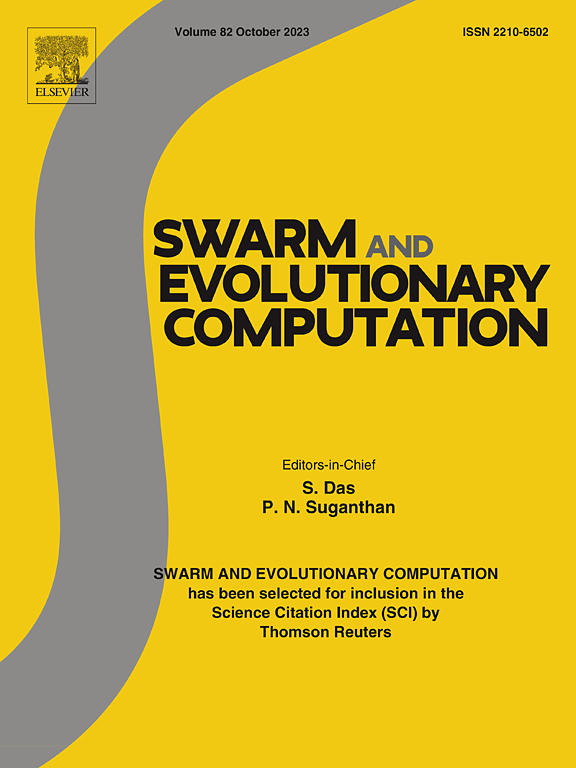基于约束收紧的约束多目标优化自适应两阶段进化算法
IF 8.5
1区 计算机科学
Q1 COMPUTER SCIENCE, ARTIFICIAL INTELLIGENCE
引用次数: 0
摘要
约束多目标优化问题在实际应用中非常普遍,但现有的方法往往难以处理约束多目标优化问题的多种特征,如不连通可行区域和靠近真约束Pareto前沿的不可行解。为了解决这些问题,本文提出了一种基于约束收紧的自适应两阶段进化算法(CT-TSEA),该算法结合了约束边界收紧策略和参数动态调整策略。在第一阶段,基于评价计数的约束边界收紧策略引导种群向可行区域移动。首先,放宽约束边界以彻底探索解空间,识别有希望的解。随着评价的增加,搜索边界缩小,提高了解决方案的可行性。此外,采用步长自适应调整方法,利用不可行解的信息改进不可行解,提高了搜索效率和解的多样性。第二阶段引入交叉概率和比例因子的动态调整方法,平衡勘探和开采。它更好地平衡了人口的勘探和开采能力。通过比较来自四个基准套件和21个实际问题的59个测试实例,验证了所提出的方法与七个最先进的同行竞争对手的有效性。结果表明,CT-TSEA在处理复杂的cmpp方面具有较高的竞争力。本文章由计算机程序翻译,如有差异,请以英文原文为准。
Constraint-tightening based adaptive two-stage evolutionary algorithm for constrained multi-objective optimization
Constrained multi-objective optimization problems (CMOPs) are prevalent in practical applications, yet existing methods often struggle to handle their diverse characteristics, such as disconnected feasible regions and infeasible solutions near the true constraints Pareto front (CPF). To address these challenges, this paper proposes a constraint-tightening based adaptive two-stage evolutionary algorithm (CT-TSEA) for CMOPs, incorporating a constraint boundary tightening strategy and parameter dynamic adjustment strategy. In the first stage, a constraint boundary tightening strategy based on evaluation counts guides the population toward feasible regions. Initially, constraint boundaries are relaxed to explore the solution space thoroughly, identifying promising solutions. As evaluations increase, the search boundaries shrink, enhancing the feasibility of solutions. Additionally, a step-size adaptive adjustment method improves infeasible solutions using their information, boosting search efficiency and solution diversity. The second stage introduces a dynamic adjustment method for crossover probability and scaling factor, balancing exploration and exploitation. It better balances the exploration and exploitation capabilities of the population. The proposed method is validated via comparing with seven state-of-the-art peer competitors across 59 test instances from four benchmark suites and 21 real-world problems. The corresponding results demonstrate that CT-TSEA has the higher competitiveness in addressing complex CMOPs.
求助全文
通过发布文献求助,成功后即可免费获取论文全文。
去求助
来源期刊

Swarm and Evolutionary Computation
COMPUTER SCIENCE, ARTIFICIAL INTELLIGENCEC-COMPUTER SCIENCE, THEORY & METHODS
CiteScore
16.00
自引率
12.00%
发文量
169
期刊介绍:
Swarm and Evolutionary Computation is a pioneering peer-reviewed journal focused on the latest research and advancements in nature-inspired intelligent computation using swarm and evolutionary algorithms. It covers theoretical, experimental, and practical aspects of these paradigms and their hybrids, promoting interdisciplinary research. The journal prioritizes the publication of high-quality, original articles that push the boundaries of evolutionary computation and swarm intelligence. Additionally, it welcomes survey papers on current topics and novel applications. Topics of interest include but are not limited to: Genetic Algorithms, and Genetic Programming, Evolution Strategies, and Evolutionary Programming, Differential Evolution, Artificial Immune Systems, Particle Swarms, Ant Colony, Bacterial Foraging, Artificial Bees, Fireflies Algorithm, Harmony Search, Artificial Life, Digital Organisms, Estimation of Distribution Algorithms, Stochastic Diffusion Search, Quantum Computing, Nano Computing, Membrane Computing, Human-centric Computing, Hybridization of Algorithms, Memetic Computing, Autonomic Computing, Self-organizing systems, Combinatorial, Discrete, Binary, Constrained, Multi-objective, Multi-modal, Dynamic, and Large-scale Optimization.
 求助内容:
求助内容: 应助结果提醒方式:
应助结果提醒方式:


